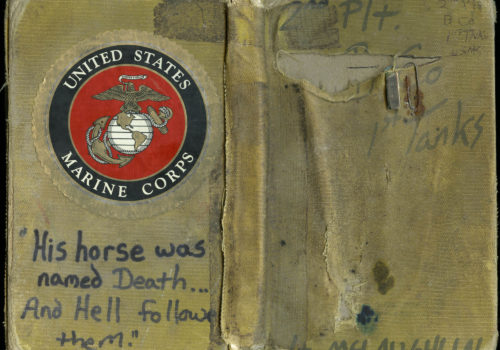The Bronx Documentary Center is gradually becoming one of New York’s most innovative art spaces, combining photography with different materials and approaches. Its latest exhibition, Invasion : Diaries and Memories of War in Iraq, on view until April 19, 2013, takes the spectator into the private lives of three people who experienced the American invasion of Iraq first-hand. We read pages from the diaries of Lieutenant Timothy McLaughlin, scanned and displayed in large format, the published and personal stories of New York Times and Wall Street Journal reporter Peter Maas, and the pictures and writings of photographer Gary Knight, founder of the VII Photo Agency.
The appeal of an exhibition like this lies in how contrasting is our vision of the Iraq War with the way it is seen in Iraq. It’s often said that the media coverage of conflicts focuses too much on battle, blood and death. This perspective is still valid, especially in photography, but it maybe demands some moderation. The Englishman Gary Knight, who has covered the majority of the world’s conflicts over the past 25 years, says: “I don’t like turning the world in a series of spectacular events. There’s something fundamentally dishonest, illegitimate and not useful in making pictures spectacular. I think war events have enough impacts by themselves. I don’t want to use the techniques of photography to enhance reality.”
At the Bronx Documentary Center, we see very few sensational images. The spectacle gives way to a subtle narrative. Elsewhere, by moving away from the standard magazine format of combined text and images, the viewer is compelled to interact, and, above all, to imagine. The texts no longer requiring visual illustrations to inform, call to mind or disturb. No extra information is needed to understand the photographs. War speaks for itself.
The exhibition also subconsciously questions media coverage of the Iraq War ten years after it began. Gary Knight has a few reservations: “After covering Iraq, I got very frustrated working on assignments for media organizations. I felt that a lot of what I was doing was just confirming the status quo and not challenging it. I was doing the same thing, producing the same images, over and over. The role of the media was very questionable in Iraq, and I didn’t want to be part of this anymore.” In his own coverage of the war, the photographer discusses his inability to provide a different perspective by gaining access to a different part of the “story,” including the struggles of the local population, which was mainly covered by local Arab photographers. “Most Western photographers were only able to follow Western soldiers.”
Keeping a diary or a personal journal, the subject of this exhibition, is common practice for war reporters. Gary Knight collects a host of items that remind him of a person or place: objects, newspapers, local magazines, tools and trinket bought in the market, “trivial” things but “no weapons.” The same goes for the photographs he took which never appeared in the press. “Most of my photographs are things that would never be published by the press, and this since I started in Cambodia. They show ordinary people in ordinary villages. These are, to me, much more important that the ones seen in newspapers. To me, they represent much more significant documents than the ones the readers are given to see.” The photographer encourages viewers to take an interest in these other images of war, which bear a different message and represent a different way to cover the war, perhaps an even more objective way when associated to the classic one. “Wars are not only bombs, fights and blood. There’s a lot of other type of scene that people don’t see published. This may be odd to say, but the war in Yugoslavia was one of the funniest experiences I ever had. I can remember lots of good moments shared with Bosnian people.”
Jonas Cuénin
Read the full article on the French version of Le Journal.
INVASION: Diaries and Memories of War In Iraq
by Tim McLaughlin, Gary Knight and Peter Maass
March 15 – April 19, 2013
The Bronx Documentary Center
614 Courtlandt Avenue (@ 151st St.)
Bronx, New York 10451
USA
T. +1 347 332-6962
Thursdays and Fridays 4pm – 7pm
Saturdays and Sundays 1pm – 5pm
Free and open to the public.
















